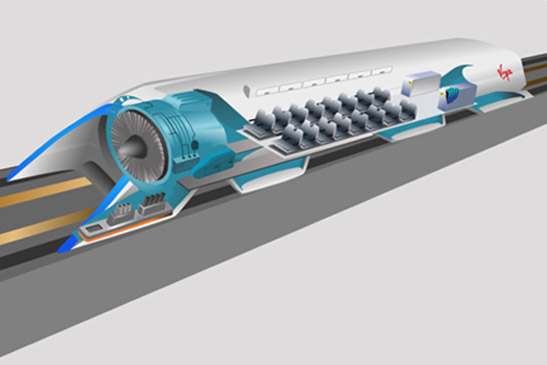
A 2015 design of the Virgin Hyperloop One, which could be a viable and fully-operational transport system in as little as 3 years from now.
The brainchild of visionary tech entrepreneur Elon Musk, Hyperloop is a revolutionary, very-high-speed travel platform that could one day link the world’s major cities in a fraction of the time it currently takes…
To put this into perspective, Hyperloop could theoretically take you from London to Edinburgh – a distance of 666km – in as little as 50 minutes, or from Madrid to Tangier (629km) in 47 minutes.
The concept of Hyperloop is as ingenious as it is daring. Loosely speaking, it is an extension of Japan’s bullet train, which uses magnetic fields to float above rails in order to avoid friction and achieve higher speeds. This effect is known as maglev, or magnetic levitation, and the technology has actually been used in monorail and train systems for several decades.
However, a critical difference between a standard maglev system and Musk’s creation, which designers say will help it reach speeds of up to 1,000km/hour, is that Hyperloop is a vactrain, or vacuum tube train. In layman’s terms, a vactrain is a train that travels through a tube in near-vacuum conditions, nullifying any air resistance – or “drag” as it is also called – thus allowing it to travel at a much higher velocity.
If you’re thinking this technology is a long way off, you’d be wrong. Hyperloop One, founded as recently as 2014 and backed by investment from Virgin, have already run a full-scale test and intend to launch the first fully-operational system in 2021.
Spain’s role in the Hyperloop movement has also been of particular interest. A group of five students from the Universitat Politècnica de València participated in the first Design Weekend back in October 2015 and have since designed some of the most innovative and groundbreaking vactrain prototypes; the latest of which will be launched in July. You can check out their website here.
Not only are there a lot of Spanish brains behind the creation of Hyperloop, but Spain may be instrumental in the rolling out of the system on a European level. The proposed continental hub will be in Málaga and the first route will be along a 77-kilometre “ghost” AVE line between Antequera and Carmona, in the province of Sevilla. This could just be the beginning for the Hyperloop network…
In light of this, you might ask: is the age of the airplane coming to an end? Is Hyperloop the future of domestic and international travel?
The answers to these questions are still some way off, but Elon Musk’s voracious speeches on the topic and his project’s ambitious objectives certainly point to rapid advances in mass-transport technology in the coming years.
 en
en



 Vlaams-Nederlands
Vlaams-Nederlands
4 Comments
Leave a Comment
DISCLAIMER
The opinions and comments expressed by contributors to this Blog are theirs alone and do not necessarily reflect the views of VIVA Homes Under the Sun Ltd, any of its associated companies, or employees; nor is VIVA to be held responsible or accountable for the accuracy of any of the information supplied.
CHRISTOPHER ROESNovember 21, 2018 at 12:08 am
LETS SEE WHAT ACTUALLY APPROACHES TO BE THE BEST MEDIUM TO TRAVEL FOR. HYPER LOOP IS INDEED A GOOD MODE OF TRANSPORT WHICH WILL REPLACE AT LEAST THE SEMI SPEED TRAINS.
Simon LivettNovember 21, 2018 at 10:38 am
Mark BridgerJune 2, 2018 at 8:28 am
So why are we intent on moving people around the globe? I understood that we were looking to stop mass transit with web based connectivity?
Simon LivettJuly 26, 2018 at 11:10 am
Have you got something to say?